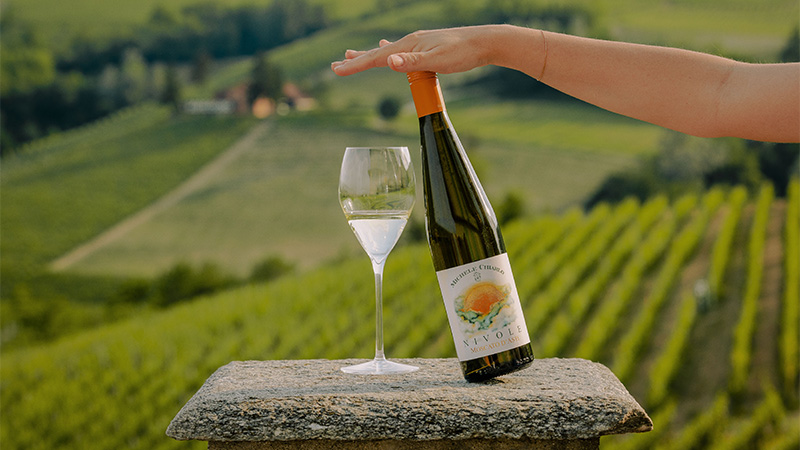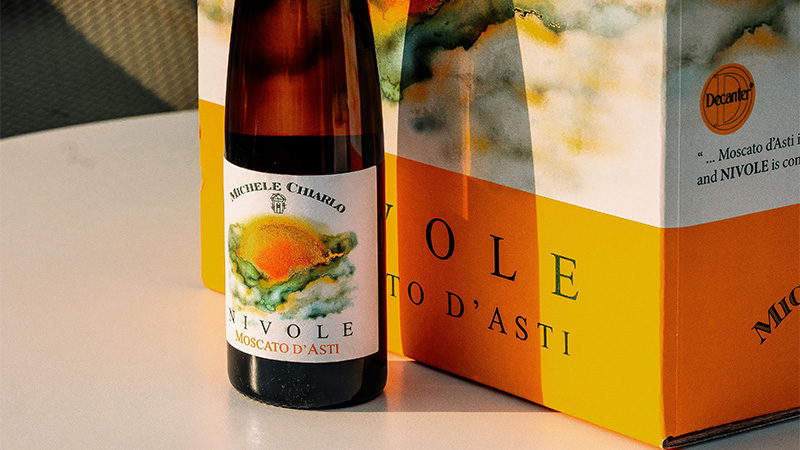
It’s the most wonderful time of the year.
No, seriously: From now through January, we have many delicious reasons to bring family, friends, and loved ones together. Whether laying out a turkey for Thanksgiving, setting a holiday dinner table for family and friends, or simply hunkering down with friends on a cozy winter evening, wine is the perfect accompaniment to an elevated spread. While we often reach for traditional, tannic reds this time of year, don’t forget the palate cleansers, the fireside charcuterie sips, and the after-dinner treats. Nivole Moscato d’Asti, a sweet wine from the Italian winemaking family of Michele Chiarlo, perks up any evening. It’s also an excellent choice for pairing with turkey, cheeses, sweet-and-spicy dishes, and more.
Moscato wines — made using the Moscato Bianco grape (the French call it Muscat Blanc à Petits Grains) — can be produced anywhere in the world, but their true home is Northern Italy’s Piedmont. The Piedmont region is rightfully considered one of the epicenters of fine food wines and has been recognized as such since before the Roman Empire. The region was declared a Unesco World Heritage Site in 2014. In addition to complex, tantalizing reds and a few outstanding whites, the area is also well known for its sparkling wines. It’s within Piedmont you’ll discover Moscato d’Asti DOCG, a legally designated wine-growing region, and home to truly lush Moscatos.
The Moscato Bianco grape is considered native here, grown on green, rolling hills boasting ideal rocky soils and excellent sun exposure. A process for making low-alcohol, slightly sweet wines in the region was introduced in the early 1600s and documented in a book by Milanese fine jeweler Giovanni Battista Croce. By the late 1800s, the softly sparkling frizzante style of Moscato we’ve come to love became more standardized. By law, the wine must come in under 5.5 percent alcohol by volume. Unlike Champagne, there is no secondary fermentation or dosage (added sugar), so any sweetness derives naturally from residual sugars in the grapes themselves during primary fermentation.
Nivole takes the category further, crafting an elegant, aromatic sparkler with notes of peach, apricot, sage, and a hint of citrus zest. Fine, subtle bubbles and bright acidity balance the naturally occurring sweetness of the low-alcohol wine. The care that goes into making Nivole starts in the vineyards. South-facing vines from the heart of the Moscato d’Asti DOCG are pruned using the Guyot method, an intensive and complex cane pruning that requires great skill. Grapes are hand-harvested, soft-pressed, and chilled. Temperature-controlled fermentation takes place in pressurized, low-temperature tanks until the wine reaches 5 percent ABV. Carbon dioxide (a natural byproduct of fermentation) is trapped in the pressurized liquid, providing light fermentation. The wine goes through a fine filtration process before bottling, which stops any additional fermentation and gives us the beautiful, clear, straw-yellow libation we all love.
In recent years, the light sweetness and subtle sparkle of Moscato d’Asti wine have been associated with casual get-togethers and Friday night celebrations. But it’s also a fantastic, semi-formal holiday dinner guest. Here are four pairing ideas to get you started:
As an Aperitif
Welcome guests with a glass of Nivole, and invite them to grab a small plate of goodies. Blue cheese (or Gorgonzola), goat cheese, prosciutto, rustic salami (think boar or venison), grapes, and grilled herbed shrimp all pair nicely. Moscato d’Asti helps stimulate the appetite but doesn’t kick the party off too quickly.
Turkey or Ham
Though sweet wines are often considered solely dessert wines, Nivole is versatile and intriguing enough to stand with the main course. Notes of apricot and garden herbs, along with a slight acidity, harmonize with the lighter meats and savory spices often found on holiday tables. It also plays nicely off sweet potatoes or candied yams.
Sweet-and-Spicy Dishes
A wide range of dishes from Southeast Asia, the Caribbean, and the southern United States marry sweet ingredients like orange sauce, maple glaze, or peanut sauce with a hint of heat. While crisp, citrusy whites work beautifully with traditional spicy dishes, the stone fruit notes and mild sweetness of Nivole Moscato d’Asti, along with its prominent floral aromatics, balance the heat-and-sweet of Korean fried chicken, any dish featuring a fruit-and-jalapeño salsa, ceviche, Moroccan tajines, Thai noodles with peanut sauce, or even good old sticky buffalo wines.
As an After-Dinner Treat
A well-made Moscato wraps up the evening with a bow on top. Either on its own or paired with lightly sweetened desserts, Nivole will leave guests feeling festive and satisfied. Avoid very sweet desserts that may make the wine taste tart in comparison. Consider dark chocolate with a high cacao percentage, a semi-sweet custard, Italian almond cookies (Ricciarelli), Mexican orejas (a pan dulce pastry), or a hard cheese like Manchego drizzled with a little dark honey and a sprinkling of fresh or dried sage.
But why stop with holiday dinners? New Year’s Eve is right around the corner!
This article is sponsored by Nivole Moscato d’Asti.




